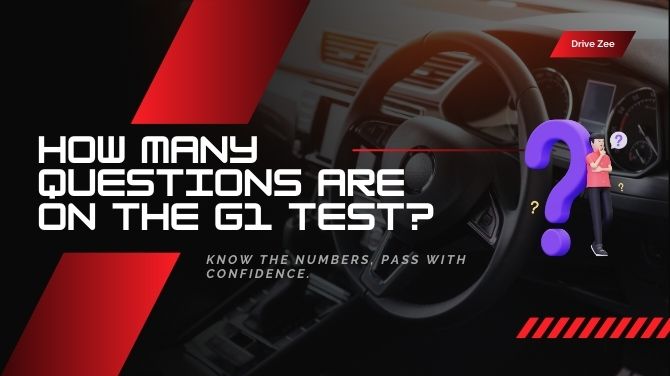Getting your G1 license is the first big step to driving in Ontario. You’ve studied the handbook, memorized road signs, and maybe even tried a few online quizzes. But now the real question hits: how many questions are on the G1 test, what are they like, and how do I make sure I pass the first time?
This guide is for learners who want clarity, confidence, and practical strategies to tackle the G1 test. We’ll go beyond “just the numbers” to cover:
- Test structure and question types
- Tips to master road signs and rules of the road
- Common mistakes and how to avoid them
- How to prepare mentally and physically for test day
- Fun anecdotes, real student experiences, and survival strategies
By the end of this guide, you’ll feel like the G1 test is something you can handle with calm, confidence, and focus.
How Many Questions Are on the G1 Test?
The G1 test consists of 40 multiple-choice questions. They are split evenly:
- 20 questions on road signs
- 20 questions on rules of the road
To pass, you must answer at least 32 correctly, which is 80 percent. That means you can miss only 8 questions total.
One of my students thought the road signs would be easy, but during the test, she hesitated between a “Yield” sign and a “Stop” sign. Luckily, she had practiced visualizing each scenario, which helped her pick the correct answer quickly. She ended up scoring 38/40.
Many learners are surprised by how scenario-based some road sign questions are. For example, a question may show a “No Left Turn” sign at a specific time of day or indicate a temporary road closure. It’s not just about memorization; it’s about understanding context.
Understanding the Breakdown
The G1 test can feel like a mystery until you know how it’s set up. Let’s break down the number of questions and how they’re divided so you know exactly what to expect before you walk in.
Road Signs Section
The road signs portion tests your knowledge of:
- Regulatory signs: Stop, yield, speed limits, no parking zones, lane-use signs
- Warning signs: Curves, pedestrian crossings, merging lanes, school zones, slippery roads
- Information signs: Hospitals, rest areas, tourist sites, highway exits
Example question: “What does a yellow diamond-shaped sign with a black arrow curving to the right indicate?”
Knowing the shape and color of a sign often helps answer quickly:
- Octagon = Stop
- Triangle = Yield
- Diamond = Warning
- Rectangle = Regulatory/Information
Pro tip: Visual memory works better than just memorizing the text. Picture the shapes in your mind as you study, and they will pop up naturally on the test. Imagine seeing the sign on a real road and think about what action you would take.
Many learners miss small details, like tiny symbols on warning signs or the difference between a Pedestrian Crossing and a School Crossing. Looking at signs in real-life settings, whether while walking or driving in your neighborhood, can make recognizing them feel natural and automatic.
Rules of the Road Section
This part covers practical driving knowledge:
- Right-of-way rules at intersections, including roundabouts and four-way stops
- Safe following distances under different conditions
- Highway and passing rules
- Parking regulations, including parallel, angled, and no-parking zones
- Emergency vehicle protocols
Example scenario question: “You approach a four-way stop. Another vehicle arrives at the same time from the right. Who has the right-of-way?”
Scenario-based questions are tricky because they test judgment, not just memory. For instance, if two cars arrive at a four-way stop at the same time, you need to know that yielding to the right is standard, but also consider gestures from other drivers.
A learner once overthought this scenario and panicked. After practicing real-life simulations in her neighborhood, she could answer confidently and passed with flying colors.
Must Check: How Many Mistakes Are Allowed in G2 Test Ontario
How Long Is the G1 Test?
The G1 test usually takes 20 to 30 minutes, depending on how quickly you read and answer. It’s better to take your time and read carefully than rush through.
A learner panicked at a question about passing on a two-lane road. By visualizing the road scenario and slowing down mentally, she picked the correct answer immediately. Visualization is a simple but powerful trick.
Even though 20–30 minutes sounds short, some questions are multi-step. You may need to:
- Analyze a scenario
- Decide the correct action
- Select the answer from multiple plausible options
Rushing increases mistakes, especially on rules-of-the-road questions.
Tips to Prepare for the G1 Test
Preparation is more than memorization. Here’s a detailed, step-by-step approach:
Study the Official Handbook Thoroughly
The Ontario Driver’s Handbook is your Bible. Highlight confusing sections, especially:
- School bus rules, including stopping distances
- Passing laws on highways and residential streets
- Roundabout etiquette and lane selection
- Speed limits in residential, school, and construction zones
Tip: Read aloud or teach someone else. Explaining rules out loud helps your brain retain them better.
Don’t ignore tables, charts, or example scenarios in the handbook. Many learners fail questions because they skipped examples showing distances, like stopping 1.5 meters behind a cyclist or 5 meters from a railway crossing.
Use Online Practice Tests
Mock tests simulate the real G1 test. They help you:
- Understand question patterns and tricky phrasing
- Identify weak spots, such as school zone rules or merging lanes
- Build timing, focus, and stamina for the real test
Pro Tip: Aim for 90% or higher in practice tests before attempting the real one. Even if you miss a few, practice reduces panic and improves recall under pressure.
A student who scored 30/40 on her first practice test was frustrated. After a week of daily 20-question timed quizzes, she scored 38/40 and felt confident enough to take the real test.
Understand, Don’t Memorize
Scenario-based questions test your logic and judgment. Memorization alone will not help.
Example: Knowing why you must stop 5 meters from a railway crossing helps answer multiple questions related to safety distances and right-of-way.
Example: Understanding why a school bus triggers a mandatory stop prepares you for different scenarios in practice tests.
One learner memorized the shape of the “Slippery Road” sign but forgot what it meant. When asked in a scenario, she visualized wet asphalt and correct driving behavior, and got it right. Understanding always beats memorization.
Learn Common Pitfalls
Some questions trick learners who memorize without context:
- Confusing Yield and Stop signs
- Misunderstanding pedestrian crosswalk rules
- Thinking you can pass a school bus from any direction
Being aware of these traps increases confidence and reduces errors.
Many questions combine road signs and scenario logic, like approaching a pedestrian crosswalk with a bus stopped nearby. Visualizing the situation in real life helps reduce mistakes.
Time Your Practice
Simulate real test conditions with timed quizzes. It helps manage stress and prevents overthinking.
One learner consistently scored 35/40 in untimed tests but jumped to 38/40 under timed conditions because practice helped him manage anxiety and focus.
Timing also helps with tricky multiple-choice wording. Some questions have “all of the above” or “none of the above,” which can confuse learners who rush.
Focus on Visual Cues
Road sign shape and color is easier to recall than exact words.
- Octagon = Stop
- Triangle = Yield
- Diamond = Warning
- Rectangle = Regulatory/Information
Think “STOP = OCTAGON = Strong” and “YIELD = TRIANGLE = Tip” to remember.
Many learners miss warning signs with symbols inside them, like bicycles, deer, or slippery roads. Associating the shape, color, and symbol with a real-life mental image makes recall automatic.
Study in Small Chunks
Don’t cram. Study 20–30 minutes at a time, then take breaks. Short study sessions improve memory retention and prevent burnout.
One learner studied 15 minutes every evening for two weeks and scored 39/40 on her practice test. The consistency beat cramming any day.
Simulate Test Scenarios
Practice by imagining real road situations:
- What to do at a four-way stop
- How to react to school buses
- Approaching highway on-ramps
- Parking and merging
Practice mentally walking through the steps. For example, approaching a school bus: mirror, signal, check both directions, stop, wait until clear, proceed. Step-by-step mental rehearsal improves real test performance.
Must Check: G2 Road Test Checklist
Test-Day Strategies for the G1 Test
How you approach the day of your test can make a huge difference. Many learners focus solely on studying and forget that mental and physical preparation matters just as much.
Arrive Early
Plan to arrive 15–20 minutes before your scheduled test time. This gives you:
- A buffer for traffic, parking, or unexpected delays
- Time to calm your nerves and breathe
- A chance to observe other learners, which helps normalize the experience
One student arrived right at her test time and felt rushed and anxious. Her hands shook, and she misread a question on the first page. The next time, arriving early and stretching for a few minutes helped her stay calm and focus.
Bring Proper Identification
You cannot take the test without ID. Bring:
- Valid government-issued photo ID
- Any required forms or receipts from the DriveTest center
Double-check requirements before the test. Some centers also require proof of residency. Missing documentation can lead to rescheduling, which adds stress.
Stay Calm and Focused
- Skip difficult questions initially and return later if allowed
- Take a deep breath before reading each scenario
- Visualize yourself handling the situation confidently
A learner panicked at a question about highway merging. She reminded herself of her practice drills, visualized the steps, and confidently selected the correct answer.
Read Carefully
Many mistakes come from misreading scenario questions:
- Look for keywords like “must,” “may,” “immediately,” or “safely”
- Watch for multiple-step instructions, such as “stop, then proceed when safe”
- Avoid rushing; accuracy is more important than speed
Some learners fail to notice time-based restrictions on signs, like “No left turn 7–9 a.m.” Reading carefully avoids these pitfalls.
Positive Self-Talk
Repeating affirmations can reduce anxiety:
- “I have studied, I understand, I can do this.”
- “I am calm, capable, and focused.”
A student whispered a short mantra in the waiting room and reported feeling less anxious during the test. Positive mental reinforcement works.
Tricky G1 Test Scenarios and How to Handle Them
Some questions simulate real-life situations that learners often find confusing. Practicing these in advance builds confidence.
Four-Way Stops
- The first vehicle to stop goes first
- If two vehicles arrive simultaneously, yield to the vehicle on your right
- Polite gestures can help, but don’t rely solely on them
One student froze at a four-way stop during practice. Visualizing each scenario multiple times helped her handle similar questions confidently on test day.
Tip: Mentally rehearse: “Stop, look left and right, check right-of-way, proceed safely.”
School Buses
- Stop when red lights flash on undivided roads from both directions
- On divided highways, only stop if you’re in the lane moving with the bus
A learner thought all buses always required stopping from every direction. After visualizing the difference between divided and undivided roads, she nailed the related questions.
Pedestrian Crosswalks
- Stop when pedestrians are present
- Never pass a vehicle stopped at a crosswalk
- Yield even if there are no signs
Pro Tip: Imagine being a pedestrian. This perspective helps reinforce safe driving behavior and reduces errors on scenario-based questions.
Highway Passing Rules
- Only pass on the left unless signs indicate otherwise
- Check mirrors and blind spots before passing
- Return to your lane only when the passed vehicle is fully visible in your rearview mirror
A student kept confusing highway passing questions until she practiced imagining merging lanes and mirror checks step by step. This made scenario questions easy to answer.
Must Check: How to Pass the G2 Driving Test in Ontario
Road Sign Mastery: Beyond Memorization
Knowing road signs is critical. Many learners memorize without truly understanding context, which can backfire on the test.
Shape and Color Recognition
- Octagon: Stop
- Triangle: Yield
- Diamond: Warning
- Rectangle: Regulatory or informational
Tip: Create flashcards with the shape on one side and meaning on the other. Shuffle and test yourself repeatedly.
Visual Mnemonics
- “STOP = strong octagon”
- “YIELD = tip of triangle”
- “Diamond = caution ahead”
A student used sticky notes with mnemonics on her study desk. Visualizing each sign in context improved recall under test conditions.
Understanding Symbols, Not Just Words
- Some signs, like “Slippery Road” or “School Zone,” show only symbols
- Visualize real-world scenarios for each symbol to improve retention
Pro Tip: Imagine driving through wet asphalt for “Slippery Road” or seeing children cross for “School Zone.” Realistic mental images stick better than rote memorization.
Top 10 Quick Tips to Pass the G1 Test
Getting ready for your G1? These quick tips will help you study smarter, stay calm, and walk into the test with confidence.
| Tip | Why It Helps |
| Read the Handbook Thoroughly | Highlight confusing rules and review them daily to strengthen memory. |
| Practice Online | Mock tests help you get used to the format and build confidence. |
| Visualize Scenarios | Picture yourself handling intersections, buses, and pedestrians. |
| Use Mnemonics | Simple tricks like “Octagon = Stop” or “Triangle = Yield” make signs easier to remember. |
| Understand, Don’t Memorize | Focus on the logic behind rules instead of rote learning. |
| Time Your Practice | Simulate test conditions so the real exam feels familiar. |
| Stay Calm on Test Day | Deep breaths and focus can keep nerves under control. |
| Skip Tough Questions Temporarily | Move on, reduce panic, and come back later with a clear head. |
| Observe Real Roads | Watch signs and traffic in daily life to train your recognition skills. |
| Learn from Mistakes | Review errors from practice tests and picture the right answers. |
A learner confused “Divided Highway Begins” and “Divided Highway Ends” on a practice test. By visualizing traffic flow with sticky notes, she mastered both and passed the real test easily.
Mental Preparation for G1 Test Day
The G1 test is as much about mindset as knowledge. Nervousness in small doses can sharpen focus.
Positive Self-Talk
Switch “I’m going to fail” to “I am prepared, I am capable.” Mental reinforcement reduces anxiety and builds confidence.
Deep Breathing Exercises
Practice the 4-4-4 technique: inhale 4 seconds, hold 4, exhale 4. Even a few breaths reset focus.
Sleep and Nutrition
- Sleep well the night before
- Eat light, energizing foods: banana, yogurt, or toast
- Stay hydrated, avoid excessive caffeine
One student skipped breakfast and felt sluggish on a practice test. A simple morning snack made her alert and improved her accuracy.
Arrive Early
- Time to relax
- Observe other drivers
- Mentally review tricky concepts
Handling Nerves
- Pause and breathe if panic arises
- Focus on one question at a time
- Recall practice wins
A student panicked on a highway passing question. Taking a deep breath, visualizing the scenario, and answering step by step helped her succeed.
FAQs
How many questions are on the G1 test?
The test has 40 multiple-choice questions. Half are about road signs and half are about rules of the road. Knowing this split makes it easier to plan your studying.
How many do I need to get right to pass?
You need at least 32 correct answers out of 40, which is 80 percent. You also need to pass both parts separately. So even if you do really well on signs, you still have to do well on the rules section too.
How long does the test take?
Most people finish in about 20 to 30 minutes, but you can take up to an hour. There’s no prize for rushing. Read carefully and take your time.
What happens if I fail?
You can try again after 7 days. Use that week to go over the questions you missed and do more practice tests. A lot of people pass the second time once they know what the test feels like.
Should I just memorize signs?
It helps to memorize them, but understanding is even better. The test might ask what you should do when you see a sign, not just what the sign means. If you know the reason behind it, the answer comes easier.
Are practice tests useful?
Yes, very. They show you the style of questions, help with timing, and point out what you still need to study. Many learners say practice tests made them feel way more confident.
Wrap Up
The G1 test has 40 questions. Half are about road signs and half are about the rules of the road. Knowing this helps you plan your study and feel more ready.
Don’t just memorize signs. Try to understand how the rules work in real driving situations. Notice small details on signs and think about what you would do in different scenarios.
Practice as much as you can. Take online mock tests, review mistakes, and focus on areas you find tricky. Visualize yourself driving and responding correctly to signs and rules.
On test day, stay calm and take your time reading each question. Trust the practice you have done. If you prepare well and stay focused, passing the G1 test is completely possible.
Want extra guidance and tips? Enroll with Drive Zee, a top-rated MTO Approved Driving School in Toronto, and get the support you need to pass with confidence.






